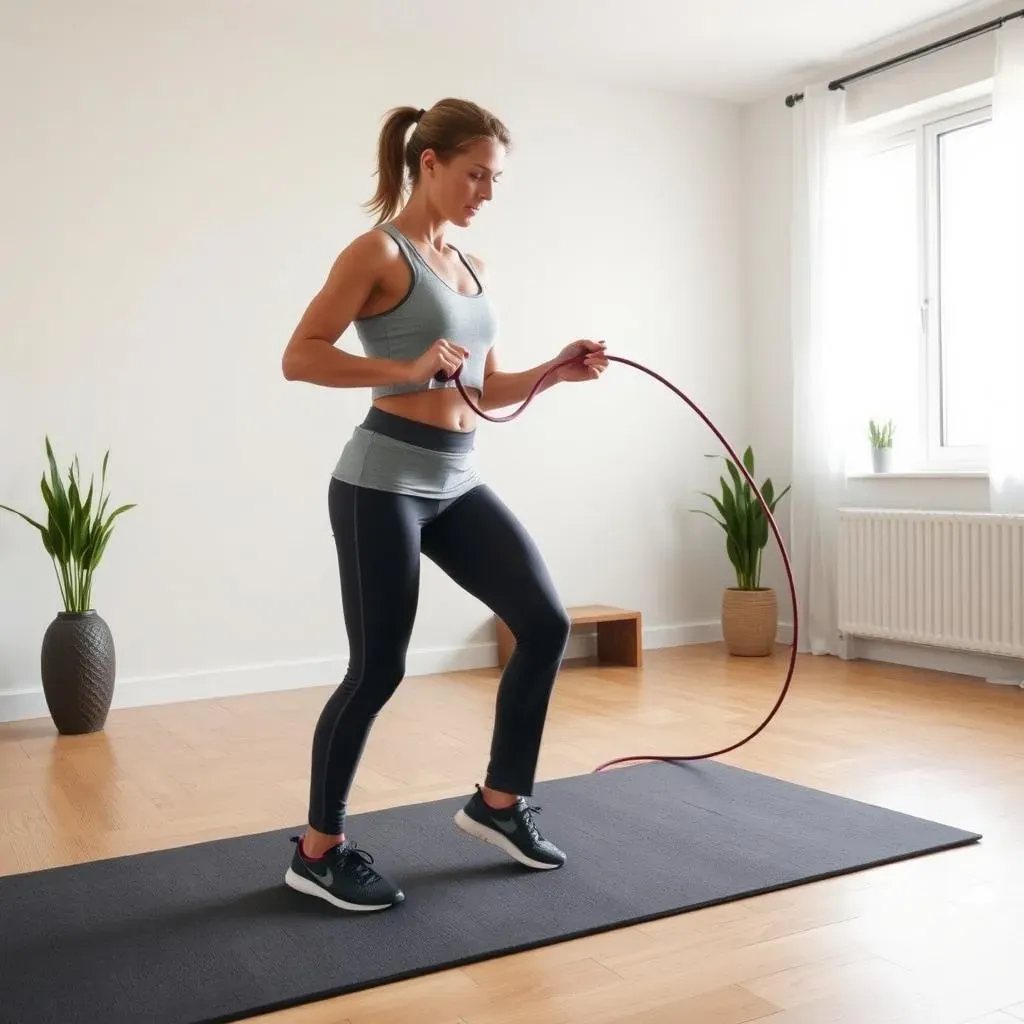Table of Contents
Ready to ditch the gym membership and sculpt a fantastic physique from the comfort of your living room? Then get ready to jump for joy! This article is your ultimate guide to achieving a full body workout at home with jump rope. We'll take you from jump rope novice to confident cardio king (or queen!) in no time. Forget boring routines; we're talking about a fun, effective, and surprisingly challenging workout that utilizes this simple piece of equipment to target every major muscle group. First, we'll cover the essential jump rope techniques to ensure you're using proper form to maximize results and avoid injury. Then, get ready to sweat with our beginner-friendly full body workout at home with jump rope routine. Looking for a more intense challenge? We've also included advanced exercises and variations to keep you engaged and progressing. Finally, we'll discuss crucial safety tips to ensure a safe and enjoyable workout journey. So grab your jump rope, clear some space, and prepare to unleash your inner athlete with this ultimate guide to a full body workout at home with jump rope.
Jump Rope Basics: Mastering the Fundamentals for Your Full Body Workout at Home

Jump Rope Basics: Mastering the Fundamentals for Your Full Body Workout at Home
Choosing Your Jump Rope
First things first: you need a jump rope! Don't worry, you don't need anything fancy. A basic jump rope will do the trick. However, if you're serious about incorporating jump rope into your regular workout routine, a weighted jump rope can provide a more intense workout and help build strength in your arms and shoulders. There are even smart jump ropes out there that track your workouts. For beginners, a standard jump rope is perfectly fine – you can always upgrade later! Think of it like starting with a basic full body workout at home for beginners before moving on to more advanced routines.
The length of your jump rope is also crucial. Stand on the middle of the rope and pull the handles up. They should reach your armpits or shoulders. Too long and you'll trip; too short, and you'll struggle. Getting the right length is vital for comfortable and effective jumping.
Jump Rope Type | Pros | Cons |
|---|---|---|
Standard | Affordable, readily available | Less challenging |
Weighted | More challenging, builds upper body strength | More expensive |
Smart | Tracks workouts, provides data | Most expensive, requires technology |
Proper Jumping Technique
Jumping rope isn't just about flailing your arms and hoping for the best. Proper technique is key to maximizing your workout and avoiding injury. Keep your core engaged, your back straight, and your feet close together. Jump lightly, using your ankles and not your knees. The rope should move from your wrists, not your elbows or shoulders. Think small, controlled jumps – not big leaps! This focuses the workout on your muscles and cardio, rather than just jarring your joints. Remember, consistency is key. Start with short bursts and gradually increase your jump time as you get stronger. For more ideas on effective home workouts, check out our guide to a effective full body workout at home.
A common mistake is swinging the rope too hard. This can lead to fatigue and potential injury. Focus on a consistent, controlled rhythm. Also, keep your eyes looking forward, not down at your feet. This will help improve your balance and coordination. Practicing in front of a mirror can help you identify any form issues you might have.
- Keep your core tight
- Jump lightly from your ankles
- Use your wrists to turn the rope
- Look forward, not down
Warm-up and Cool-down
Just like any workout, warming up before you start jumping rope is essential. A quick 5-minute warm-up, including some light cardio and dynamic stretching, will prepare your muscles and joints for the workout ahead. This could include some jumping jacks, high knees, or arm circles. Similarly, a cool-down is just as important. After your jump rope workout, take a few minutes to stretch out your muscles. This will help prevent soreness and stiffness. Focus on stretches that target your calves, quads, hamstrings, and shoulders. A proper warm-up and cool-down are crucial for injury prevention. For a low-impact option, check out our low-impact full body workout at home.
Remember, consistency is key when it comes to seeing results. Don't try to do too much too soon. Start with shorter jump sessions and gradually increase the duration and intensity as you get fitter. Listen to your body and take rest days when needed. If you're feeling pain, stop and rest. Remember, a little bit of effort goes a long way. Consider it a fun way to stay active, not a race against time. “The greatest of follies is to sacrifice health for any other kind of happiness.” – Arthur Schopenhauer
Full Body Workout at Home with Jump Rope: A Sample Routine for Beginners
Getting Started: A Warm-up and Basic Jump Rope Circuit
Let's kick things off with a simple, yet effective, beginner routine. This workout focuses on building a foundation of jump rope skills and introducing basic bodyweight exercises to create a full-body challenge. Remember, consistency trumps intensity, especially when you're starting. Aim for proper form over speed. Before you begin, warm up your body with 5 minutes of light cardio like jumping jacks or high knees. This will get your blood flowing and prepare your muscles for the workout. Don't forget to stretch those calves! After your warm-up, we'll start with a basic jump rope circuit. This circuit involves alternating between 30 seconds of jumping rope and 30 seconds of rest. Repeat this cycle for a total of 10 minutes.
This is a great starting point for building your jump rope stamina and getting comfortable with the basic movements. Once you've completed the 10-minute jump rope circuit, cool down with some light stretching. Focus on your calves, hamstrings, and shoulders. Holding each stretch for at least 30 seconds will help improve your flexibility and prevent muscle soreness. For additional low-impact workout ideas, check out our guide to a low-impact full body workout at home.
- Warm-up (5 minutes): Jumping jacks, high knees, arm circles
- Jump Rope Circuit (10 minutes): 30 seconds jump rope, 30 seconds rest (repeat)
- Cool-down (5 minutes): Static stretches for calves, hamstrings, and shoulders
Adding Bodyweight Exercises: A Full-Body Jump Rope Blast
Now that you've mastered the basics, let's add some bodyweight exercises to turn your jump rope workout into a full-body blast. This routine incorporates exercises that work different muscle groups, ensuring a well-rounded workout. Remember to maintain good form throughout the workout. This routine is designed to be challenging but manageable for beginners. You can adjust the number of repetitions or rest periods based on your fitness level. After a 5-minute warm-up (similar to the previous routine), we'll start with a 30-second burst of jump rope, followed by 30 seconds of squats. We’ll then do 30 seconds of push-ups (modified push-ups against a wall are perfectly acceptable!), followed by another 30-second jump rope burst. Repeat this cycle for a total of three rounds.
After the three rounds, take a short break, and then repeat the cycle with a different combination of exercises. For example, you could try jump rope followed by lunges, then jump rope followed by planks. Get creative and mix it up! Remember to listen to your body and take breaks when needed. The goal is to challenge yourself while maintaining good form. If you're looking for more challenging exercises, check out our full body workout at home for muscle gain for additional inspiration.
Exercise | Duration | Sets | Reps (if applicable) |
|---|---|---|---|
Jump Rope | 30 seconds | 3 | N/A |
Squats | 30 seconds | 3 | As many as possible |
Push-ups | 30 seconds | 3 | As many as possible |
Level Up Your Full Body Workout at Home with Jump Rope: Advanced Exercises and Variations

Level Up Your Full Body Workout at Home with Jump Rope: Advanced Exercises and Variations
Advanced Jump Rope Techniques
Once you're comfortable with basic jumping, it's time to spice things up! Try incorporating advanced techniques like double unders (two rope rotations per jump), high knees, and criss-crosses. These moves will seriously challenge your coordination and cardiovascular fitness. Don't get discouraged if you don't master them right away; practice makes perfect! Start slowly, focusing on form before speed. You might find it helpful to watch videos online to see how these techniques are performed. Remember, consistency is key – even short bursts of practice each day can make a big difference. For a more comprehensive approach to home workouts, check out our guide to the best full body workout at home.
Another great way to challenge yourself is to incorporate interval training. This involves alternating between high-intensity periods of jump rope with short rest periods. For example, you could try 30 seconds of high-intensity jumping followed by 30 seconds of rest. Repeat this cycle for 10-15 minutes. This type of training is highly effective for improving cardiovascular fitness and burning calories. You can adjust the duration of the high-intensity and rest periods based on your fitness level. Remember to listen to your body and take breaks when needed.
- Double Unders
- High Knees
- Criss-Crosses
- Interval Training
Incorporating Calisthenics: Full-Body Strength
To truly transform your jump rope workout into a full-body powerhouse, integrate calisthenics exercises between jump rope intervals. Think squats, push-ups, lunges, planks – the possibilities are endless! These exercises will help build strength and muscle endurance, complementing the cardio benefits of jump rope. Start with a simple routine that you can manage with good form. As you get stronger, gradually increase the number of repetitions or sets. This will challenge your muscles and improve your overall fitness. For a more detailed plan, check out our full body workout at home for muscle gain.
Remember to focus on proper form to prevent injury. If you're unsure about the correct technique for any exercise, consult a fitness professional or watch instructional videos online. A well-rounded full-body workout should include a mix of cardio and strength training. Jump rope provides the cardio element, while calisthenics builds strength and muscle. This combination is highly effective for improving overall fitness and achieving your fitness goals. Don't be afraid to experiment with different combinations of exercises and intervals to find what works best for you. The key is to find a routine that you enjoy and can stick with consistently.
Exercise | Muscle Group | Sets | Reps |
|---|---|---|---|
Jump Rope | Cardiovascular | 3 | 30 seconds each |
Squats | Legs, Glutes | 3 | 10-15 |
Push-ups | Chest, Shoulders, Triceps | 3 | As many as possible |
Lunges | Legs, Glutes | 3 | 10-15 per leg |
Plank | Core | 3 | 30 seconds |
Full Body Workout at Home with Jump Rope: Safety Tips and Considerations for Injury Prevention

Full Body Workout at Home with Jump Rope: Safety Tips and Considerations for Injury Prevention
Choosing the Right Surface
Before you even think about jumping, consider your jumping surface. Hard surfaces like concrete are a recipe for shin splints and other injuries. Opt for a softer surface like a gym mat, carpet, or even grass. This will cushion your joints and reduce impact, making your workout safer and more comfortable. A good surface is key to preventing injuries, and it'll also make your jumps feel smoother and more controlled.
Think of it like this: would you rather jump rope on a bouncy castle or a concrete sidewalk? Exactly! Protecting your joints should always be a top priority. For those who are new to working out, it's also a good idea to start slow. Don't jump for long periods initially, and make sure to listen to your body and take breaks when needed. A gradual increase in workout duration and intensity is essential for preventing injuries and building stamina. If you are looking for a gentler approach to full-body exercise, check out our guide to low-impact workouts.
- Avoid hard surfaces like concrete
- Use a gym mat, carpet, or grass
- Start slowly and gradually increase intensity
Listening to Your Body and Preventing Overuse Injuries
This might sound obvious, but it's crucial: pay attention to your body! If you feel any pain, stop immediately. Pushing through pain is never a good idea; it can lead to serious injuries. Rest and recovery are essential parts of any fitness routine. Don't jump every day; give your body time to recover between workouts. Remember, consistency is key, but so is rest! Overtraining can lead to injuries, burnout, and ultimately, hinder your progress. A balanced approach that includes both training and recovery is far more sustainable and effective in the long run.
Also, consider your overall fitness level. If you're a beginner, start with shorter workouts and gradually increase the duration and intensity. Don't try to do too much too soon. Remember to stay hydrated and fuel your body properly. Proper nutrition and hydration are vital for muscle recovery and overall health. A balanced diet and sufficient water intake are essential for optimal performance and injury prevention. If you're looking for more ways to incorporate fitness into your daily life, you might find our guide to workouts for busy schedules helpful.
Symptom | Possible Cause | Solution |
|---|---|---|
Knee pain | Overuse, improper form | Rest, ice, modify workout |
Shin splints | Hard surfaces, improper footwear | Softer surface, supportive shoes |
Muscle soreness | Overtraining, insufficient warm-up/cool-down | Rest, stretching, proper warm-up/cool-down |
